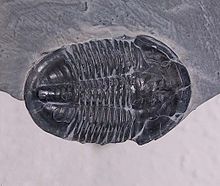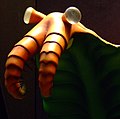Wheeler Shale
The Wheeler Shale , often also referred to as the Wheeler Formation , is a rock formation in the US state of Utah . It originated in the middle Cambrian about 507 million years ago and contains a concentrate deposit with exceptionally well-preserved fossils .
The Wheeler Shale achieved world fame through the discovery of excellently preserved trilobites , for example Elrathia kingii ( state fossil of Utah), as well as various representatives of the agnostids . Organisms without a mineral skeleton, such as Naraoia , Wiwaxia and Hallucigenia , are also preserved in the Wheeler Shale. The conservation mode ( carbon-rich , film-like coating) of this “soft body fauna ” is reminiscent of the conserved deposits of the Burgess slate type.
Naming
The Wheeler Shale was named in 1908 by Charles Walcott for its type locality , the Wheeler Amphitheater, a semicircular depression in the northeastern House Range . The Wheeler Amphitheater, like many other locations in the American Southwest, was named in honor of the officer and surveyor George Montague Wheeler .
Occurrence and geological framework
The Wheeler Formation in western Utah extends from the ridge of the House Range (in Millard County ) about 40 kilometers northeast to the Drum Mountains (in Juab County ). The Drum Mountains also have similar fossils with a comparable state of preservation. A smaller deposit can be found in the Canyon Mountains of central Utah. The mountain ranges mentioned are raised clumps that geologically belong to the eastern Basin and Range . In them occur otherwise covered Cambrian now sedimentary sequences largely days. Due to the neogene expansion tectonics , the layer structure was partly tilted - in the House Range z. B. therefore the sediments mostly strike north-northeast to northeast and dip flat (10 to 20 °) to the east.
Facies
The sediments of the Wheeler Shales are of tropical marine origin and were deposited on the passive continental margin of Laurentia, around 300 kilometers wide, in a sea bay, the House Range Embayment (HRE). The gradually rising sea level due to the sinking of the continental margin is documented by falling δ 13 C values. The relatively low-oxygen basin of the House Range Embayment was very likely marked out by faults and lay in the immediate vicinity of the broad Laurentian carbonate shelf . Several sedimentary facies can therefore be found in the Wheeler Shale at the same time : In the Drum Mountains, whose deposit area was relatively close to the shelf edge, a carbonate-rich shelf and shelf edge facies were deposited, whereas in the area of the House Range the basin facies dominate.
Lithology and stratigraphy
The mostly olive to dark-colored Wheeler Shale consists predominantly of homogeneous, fine-grain shale clays ( black slate sediments with grain sizes below 50 μm and a carbonate content of 17 to 47 percent by weight ), in which thinly banked carbonate layers can be incorporated. It was deposited below the wave base as low-energy sediment under anoxic conditions. The carbonate component can be explained by the nearby shelf edge.
The profile of the type locality in the House Range consists of heterogeneous deposits of limestone marl , marl limestone, claystone and thin-banked plate limestone. In the Drum Mountains found spotty as shelf basin sediments, thin-layer Sparite , in the open shelf area rhythmites and subsequent lower slopes mudstones.
At the Marjum Pass coordinates: 39 ° 15 '0 " N , 113 ° 20' 0" W in the House Range, the Wheeler Shale is 190 meters thick , and in the Drum Mountains 40 kilometers to the northeast, the thickness increases to 306 meters on. Stratigraphically, it follows the resistant limestone formation of the Swasey Limestone , from which it clearly sets itself apart with its much gentler terrain. Together with the overlying Marjum Formation and the lower Weeks Formation that follows it , it represents one of the most powerful, well-exposed and fossil-rich Central Cambrian sequences in North America.
Biostratigraphically , the Wheeler Shale lies within the laurent trilobite zone Bolaspidella . It also documents the first appearance of the trilobite Acidusus atavus ( Ptychagnostus atavus ), which replaces Ptychagnostus gibbus (beginning of the drumium ), 62 meters above its base . Ten meters higher is a negative carbon isotope anomaly that is associated with a transgression peak.
fauna
The fauna found consists of algae , annelid worms , various arthropods (e.g. anomalocarids , emeraldella , phyllocarids ), brachiopods , carpoids , chancellorids , eocrinoids , priapulids , jellyfish , sponges , primitive echinoderms , trilobites and trilobites.
Rare microfossils are acritarches , conodonts and radiolarians .
Taphonomy and biofacies
Strangely enough, hardshells like trilobites and organisms with soft body preservation never appear in the same layer with one another. Gaines and Droser (2005) explain this fact with the oxygen content of the seawater near the ground and with the degree of bioturbation . Soft body maintenance took place in deeper, anaerobic pelvic sections with minimal bioturbation. The hard shell, on the other hand, are found in higher dysaerobic areas that have been more heavily ransacked. The appearance of Elrathia kingi (i) marks the transition. An exception to this scheme are the agnostids, which can be found anywhere as planktonic living organisms.
In detail, the following biofacies can be distinguished (arranged according to increasing water depth or decreasing oxygen content or less digging):
| Biofacies | Oxygen content | Bioturbation | Taphocenosis |
|---|---|---|---|
| Bolaspidella | dysaerobic | uniformly rummaged through | impoverished - Bolaspidella |
| Asaphiscus | dysaerobic | weakly ransacked | various trilobites - Asaphiscus , Alokistocare , Olenoides |
| Elrathia | exaerobic | onset of bioturbation | monospecific - Elrathia kingii |
| Proximal soft body facies | anaerobic | unavailable | Metazoa |
| Distal soft body facies | anaerobic | unavailable | pelagic algae - Marpolia spissa pelagic trilobites - Brachyaspidion microps |
Fauna sorted by tribes
Reich Protista (seaweed)
- Margaretia dorus
- Marpolia spissa - cyanobacteria
- Morania fragmenta - cyanobacteria
- Yuknessia simplex - green alga ?
Phylum Arthropoda (arthropod)
- Branchiocaris pretiosa - Crustacea
- Branchiocaris sp.
- Canadaspis cf. perfecta
- Dicerocaris opisthoeces
- Pahvantia hastata
- Perspicaris dilatus
- Proboscicaris agnosta
- Pseudoarctolepis sharpi - Phyllocarida
- Tuzoia? peterseni
- Cambropodus gracilis - Uniramia
Phylum Arthropoda - Arachnomorpha
- Alalcomenaeus cf. cambrius
- Dicranocaris guntherorum
- Mollisonia symmetrica
- Naraoia
- Sydneyia sp.
Phylum Arthropoda - class Trilobita

- Baltagnostus eurypyx - order Agnostida
- Hypagnostus parvifrans
- Peronopsis amplaxis
- Peronopsis bidens
- Peronopsis fallax
- Peronopsis gaspensis
- Peronopsis intermedius
- Peronopsis interstrictus
- Peronopsis montis
- Peronopsis segmentis
- Ptychagnostus atavus = Acidusus atavus
- Ptychagnostus germanus
- Ptychagnostus gibbus
- Ptychagnostus intermedius
- Ptychagnostus michaeli
- Ptychagnostus occultatus
- Ptychagnostus seminula
- Glyphaspis concavus - order Asaphida
- Bathyuriscus fimbriatus - order Corynexochida
- Kootenia species - very rare!
- Olenoides expansus
- Olenoides nevadensis
- Olenoides serratus
- Tonkinella breviceps
- Zacanthoides divergens
- Zacanthoides sp.
- Altiocculus harrisi - order Ptychopariida
- Alokistocare sp.
- Asaphiscus wheeleri
- Bathyocos housensis
- Bathyuriscus sp.
- Bolaspidella drumensis
- Bolaspidella housensis
- Bolaspidella sp.
- Bolaspidella wellsvillensis
- Brachyaspidion microps
- Brachyaspidion sulcatum
- Cedaria minor
- Elrathia kingi (i)
- Elrathia sp.
- Elrathina wheeleri = Ptychoparella wheeleri
- Jenkinsonia varga
- Modocia brevispina
- Modocia laevinucha
- Modocia typicalis
- Ptychoparella sp.
- Ptychoparella wheeleri
- Spencella sp.
Tribe Brachiopoda (armpods)
- Acrothele subsidua
Tribe Chordata (chordates)
Cnidaria tribe (cnidarians)
Tribe Lobopodia (Lobopods)
- Aysheaia prolata
- Hallucigenia
Tribe Mollusca (molluscs)
Phylum Echinodermata ( Echinoderms )
- Castericystis sp. - Carpoidea
- Castericystis sprinklei
- Cothurnocystis sp.
- Ctenocystis sp. - Ctenocystoidea
- Gogia spiralis - Eocrinoidea
Phylum Porifera (sponges)
- Chancelloria pentacta - Chancelloriidae
- Choia carteri
- Choia utahensis
- Crumillospongia
- Diagonella
Tribe Priapulida ( priapulida )
Taxa with uncertain assignment
- Anomalocaris nathorsti - Anomalocaride
- Anomalocaris sp.
- Eldonia
- Hylolithellus sp - worm -like
- Wiwaxia
gallery
See also
Web links
- Welcome to U-DIG Fossils. Commercial quarry in the Wheeler Shale (fossil collection for a fee) with picture gallery.
- Geological map of the Utah Geological Survey at a scale of 1: 100,000 (PDF file; 18 MB)
Individual evidence
- ↑ Kirk Johnson & Ray Troll: Cruising the fossil freeway: An epoch tale of a scientist and an artist on the ultimate 5,000-Mile paleo road trip . Fulcrum Publishing, Golden, Colorado 2007, ISBN 978-1-55591-451-6 .
- ^ A b Robert R. Gaines, Derek EG Briggs, Zhao Yuanlong: Cambrian Burgess Shale - type deposits share a common mode of fossilization . In: Geology . 36, 2008, pp. 755-758. doi : 10.1130 / G24961A.1 .
- ^ Robert R. Gaines: A New Hypothesis for Organic Preservation of Burgess Shale Taxa in the Middle Cambrian Wheeler Formation, House Range, Utah . In: Palaeogeography Palaeoclimatology Palaeoecology . 220, 2005, pp. 193-205. doi : 10.1016 / j.palaeo.2004.07.034 .
- ↑ a b c L.F. Gunther & VG Gunther: Some Middle Cambrian Fossils of Utah . In: Brigham Young University Geology Studies . 28, 1981, pp. 1-81.
- ↑ Rees, MN: A fault-controlled through a carbonate platform: the middle Cambrian House Range embayment . In: GSA Bulletin . 97, 1986, pp. 1054-1069.
- ^ Langenburg, ES and Liddell, WD and Dehler, CM 2002. Geochemistry And Sequence Stratigraphy of the Middle Cambrian Wheeler Formation: Support for Trilobite Chronostratigraphy. Geol. Soc. At the. Abstr. w / prog. 33
- ^ RA Robison: Late Middle Cambrian faunas from western Utah . In: Journal of Paleontology . 38, 1964, pp. 510-566.
- ↑ Loren E. Babcock, Richard A. Robison, Margaret N. Rees, Shanchi Peng & Matthew R. Saltzman: The GSSP of the Drumian Stage Archived from the original on June 17, 2009. Info: The archive link was automatically inserted and not yet checked . Please check the original and archive link according to the instructions and then remove this notice. In: Episodes . 30 N ° 2, June 2007, pp. 85-95. Retrieved January 7, 2009.
- ^ DEG Briggs & RA Robison: Exceptionally preserved nontrilobite arthropods and Anomalocaris from the Middle Cambrian of Utah . The Paleontological Institute, The University of Kansas, 1984 ( online ).
- ↑ Photos of Wheeler Shale fossils from UC Berkeley
- ^ JK Rigby: Porifera of the Middle Cambrian Wheeler Shale, from the Wheeler Amphitheater, House Range, in western Utah . In: Journal of Paleontology . 52, No. 6, 1978, pp. 1325-1345.
- ^ Utah's Cambrian Life from University of Kansas Natural History Museum
- ↑ Cambrian fossils from Utah by the University of Utah ( page no longer available , search in web archives ) Info: The link was automatically marked as defective. Please check the link according to the instructions and then remove this notice.
- ↑ Comprehensive treatment from The Virtual Fossil Museum
- ↑ Gaines et al. a .: Taphonomy of soft-bodied preservation and ptychopariid deposit in the Wheeler Shale (Middle Cambrian), House Range, USA; controls and implications . In: PaleoBios . 21 (Suppl. 2), 2001, pp. 1-55.
- ↑ Robert R.Gaines, Mary L.Droser: New Approaches to Understanding the Mechanics of Burgess Shale-type Preservation: From the Micron Scale to the Global Picture Archived from the original on January 15, 2009. Info: The archive link was automatically inserted and still Not checked. Please check the original and archive link according to the instructions and then remove this notice. In: The Sedimentary Record . 3 N ° 2, 2005, pp. 4-8. Retrieved January 10, 2009.







